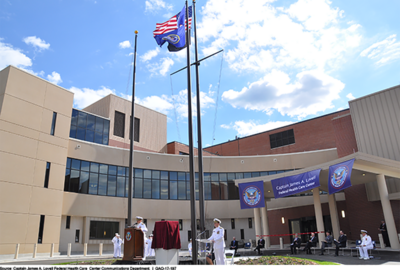
VA pivoting away from $2.6 billion logistics system that failed to meet user needs
VA says it wants an evolving technology-as-a-service approach to manage its multibillion dollar logistics enterprise, and plans to select its own vendor to handle...
Best listening experience is on Chrome, Firefox or Safari. Subscribe to Federal Drive’s daily audio interviews on Apple Podcasts or PodcastOne.
The Department of Veterans Affairs says it’s ready to start moving away from the multibillion dollar IT platform it had intended to use to manage its massive health care logistics enterprise, and will now use its own contract vehicle to replace its troubled implementation of the Defense Medical Logistics Standard Support system (DMLSS).
Officials said Tuesday they are now reducing the scope and funding of their previous $2.6 billion interagency agreement with DoD to use the DMLSS system, whose implementation at VA has not gone well. In its place, VA is planning a new, more expansive supply chain modernization effort that will be managed by a single vendor or team of vendors over the next ten years.
Michael Parrish, the department’s chief acquisition officer, said VA hasn’t fully determined what the new solution will look like yet. To do that, the department first wants to prototype potential offerings from several different companies and simultaneously gather feedback from end users.
“One of the structural ideas we’re trying to do with this new approach is to get a technology solution out to our field as quickly as possible,” Parrish told reporters Tuesday. “We’re doing an initial downselect to the potential solution providers, and we’re doing this as a technology-as-a-service approach. From there, we expect those finalists to be able to do competitive prototyping in a demonstration that is evaluated by our field. From there, we’ll pick the winning finalist.”
While VA hasn’t committed to a specific timeline to implement the new contract, the department is aiming to select the candidates for the prototyping portion of the acquisition by Spring 2023, and to select a winner for the single-award indefinite-delivery/indefinite-quantity contract by midway through calendar year 2023.
The 10-year price tag for the new contract could be in the neighborhood of $1 billion, but VA officials emphasized that the total cost hasn’t been determined yet.
One reason for that is that VA is still determining exactly what its new approach to supply chain management will be in collaboration with potential contract winners. Rather than defining concrete requirements in a formal performance of work statement, the draft solicitation documents VA has issued thus far lay out a statement of objectives.
“When we think about a commercial solution and a fixed price contract, it’s important for us as the customer to describe our needs, wants and desires. Instead of presupposing an engineering solution, we’re leaving it to industry to tell us how to do it,” Parrish said. “The other big game changer is we’re not buying a product — we’re not going to buy obsolete hardware or software, we’re expecting the solutions provider to have a modular, evergreen type of process. We expect best-in-class technology in this complex system of systems. We’ve been working with industry for this past year to get to this point, and everybody acknowledges that it’s a very complex system.”
It’s complex, in part, because the new supply chain acquisition won’t just replace DMLSS. VA wants it to subsume and integrate the functions of 58 separate logistics and ordering systems across the Veterans Health Administration, the Veterans Benefits Administration, and the National Cemetery Administration.
To provide government oversight over that complicated integration work, VA also plans to stand up a new Office of Enterprise Supply Chain Modernization in the next few months. The Government Accountability Office and VA’s inspector general have previously criticized the department’s logistics modernization efforts for ineffective oversight and inconsistent leadership.
Dave Sloniker, VA’s executive director for logistics redesign, will lead the new office. He said the government’s oversight role will be different from previous logistics modernization efforts.
“What we’ve learned coming out of these conversations is that it’s not just the system, it’s the people, processes and technology — it’s the change management approach you get by having not just user buy-in, but ownership of the concept you’re moving toward,” Sloniker said. “This new office will look at the whole environment: Here are the things that need to be changed in terms of process and policy. Our current policies are driven around our current systems, but if you change the system, you have to come in and redesign your process and policies, so we’re going to look at both issues at the same time … we want to achieve a better veterans experience and a better user experience for the people who are using it.”
Until recently, VA had been planning to use DoD’s already-aging DMLSS system to manage supply chain logistics across the entire Veterans Health Administration for the next 15 years.
But VA’s inspector general reported last year that the system showed major capability gaps at its first pilot site in Chicago: it failed to meet 44% of the staff’s operational requirements. Also last year, an internal review by the department’s own senior leadership recommended cancelling VA’s use of DMLSS, and in January of this year, a bipartisan group of VA’s congressional overseers called for the same thing.
Parrish said the department has spent the months since then figuring out both the current state of its logistics enterprise and the new way forward.
“We realized that, instead of piecemeal, we’ve really got to make it an enterprise-wide approach. One of my doctrines is it has to be easy to use, integrated and intelligent,” he said. “The other big game changer in this approach is the competitive prototyping aspect. We’re saying [to vendors], ‘Hey, instead of giving us a great pitch for a potential billion dollar program, show us how it actually works, and let’s test drive this thing before we actually get it out.’ We’re getting the buy-in, the cultural acceptance, the industry and user feedback items up front — the hard stuff — before we actually commit to technology. We had to understand what our processes were, understand our skillsets, and then our definitions of success and measures of success.”
Copyright © 2025 Federal News Network. All rights reserved. This website is not intended for users located within the European Economic Area.
Jared Serbu is deputy editor of Federal News Network and reports on the Defense Department’s contracting, legislative, workforce and IT issues.
Follow @jserbuWFED
Related Stories





